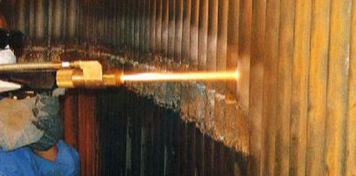

Thermal spraying technology uses a certain heat source to heat and melt or semi-melt the thermal spray material, and atomize it by flame flow or external high-speed air flow, and then spray it on the surface of the substrate (workpiece), and combine with the substrate to form a functional coating. method. Thermal spraying technology creates a special working surface on the surface of ordinary materials to achieve: anticorrosion, wear resistance, friction reduction, high temperature resistance, oxidation resistance, heat insulation, insulation, electrical conductivity, anti-microwave radiation, etc. Function to achieve the purpose of saving materials and energy. We call the special working surface coating, and the working method of manufacturing the coating is called thermal spraying. Thermal spraying technology is one of the important components of surface process technology, accounting for about one-third of surface engineering technology.

Shangpu Consulting industry analyst pointed out: The main connotation of thermal spraying technology should include materials, equipment and technology (including pretreatment, spraying process, post-processing) three aspects. The initial thermal spraying can only use metal wire with a lower melting point as the material, and flame as the heat source to spray anti-corrosion coatings and perform maintenance services, so it is called "metal spraying." During the Second World War, the emergence of self-fluxing alloy powder enabled powder flame spraying to obtain large-scale industrial applications. After the war, the aviation and aerospace industries developed rapidly, and high-melting-point metals or alloys and ceramic materials became practical with the emergence of atmospheric plasma spraying technology. The successful development of self-adhesive composite powder represented by nickel and aluminum has played an important role in further improving the bonding force of the coating.
With the improvement of spraying equipment and the subsequent development of new processes such as explosive spraying, low-pressure plasma spraying, and supersonic flame spraying, the realization of high-quality coatings is possible, and thermal spraying materials for various purposes have emerged accordingly. For a long period of time, thermal spraying equipment and processes have been pursuing the high energy of the heat source and the high speed of the particles, and the pursuit of high efficiency of the spraying process through operation automation, and ultimately improving the quality and stability of the coating. Over the past century, thermal spraying materials have evolved from several metal wires to hundreds of thermal spraying materials that meet the needs of different process operations and different use characteristics. The thermal spraying material obtains a coating of a certain composition and structure through a spraying method (equipment, process), and then obtains the required coating characteristics. In a broad sense, thermal spraying technology is a means of material compounding. It can be said that the diversity of thermal spray coating functions or the adaptability to different specific uses depends on the material. The development of thermal spraying materials and spraying methods promote each other, and the two together promote the progress of the entire thermal spraying technology.
Thermal spray technology is also used in many task industries. At present, the key customers of thermal spray technology are mainly concentrated in many domestic fields such as papermaking, machinery, electricity, transportation, construction, glass, aerospace, petrochemical, and light industry. The vast market area brings many opportunit
Hot information

